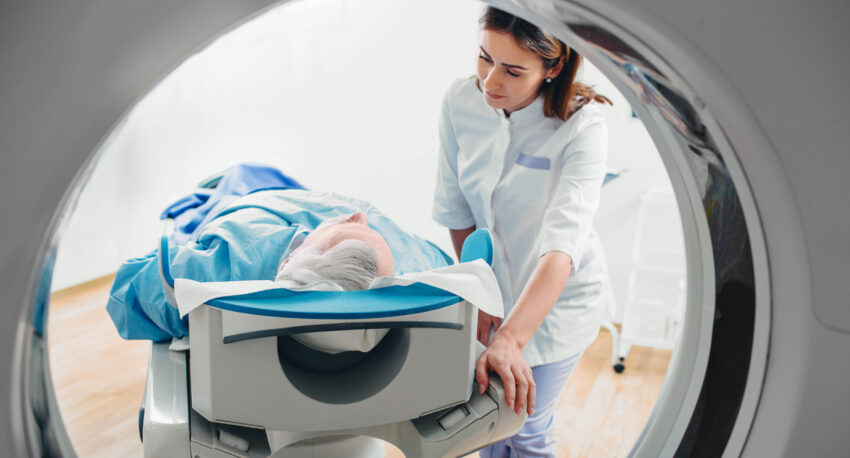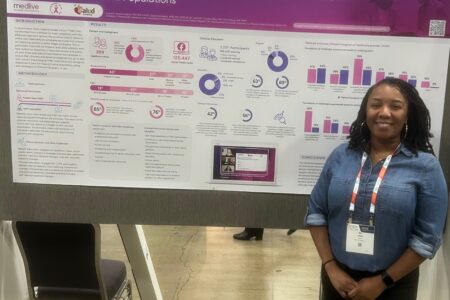
Share On Social!
Did you know about 90,000 people are diagnosed with a primary brain tumor every year?
Similarly, over 1.3 million people in the United States are living with a primary or secondary/metastatic brain tumor.
For ourselves, our familia, and our comunidad, we should know a few important things about brain tumors so we can help all those impacted by a tumor diagnosis.
Thankfully, the American Brain Tumor Association (ABTA) has amazing resources to help.
Let’s explore and learn!
Access this resource in Spanish!
1. Know the Types of Brain Tumors
A brain tumor is a growth of abnormal cells that have formed in the brain.
But not all brain tumors are the same.
“Some brain tumors are malignant (cancerous), while others are not (non-malignant, non-cancerous or benign). A brain tumor can form in the brain or other parts of the central nervous system (CNS), such as the spine or cranial nerves,” according to ABTA.
Whether a tumor is malignant or not depends on how quickly the cells reproduce.
If the tumor is made up of cells that multiply slowly, then it is usually non-malignant; however, if the cells multiply and spread quickly, then the tumor is malignant.
These types of brain tumors are cancerous:
- Gliomas
- Astrocytomas
- Ependymomas
- Glioblastoma multiforme (GBM)
- Medulloblastomas
- Oligodendrogliomas
“These types of tumors generally grow faster, and are more aggressive than non-malignant tumors. They often spread and damage other areas of the brain and spinal cord. Malignant brain tumors need to be treated as soon as possible to prolong life,” according to ABTA.
These types of brain tumor are not cancerous:
- Chordomas
- Craniopharyngiomas
- Gangliocytomas
- Glomus jugulare
- Meningiomas
- Pineocytomas
- Pituitary adenomas
- Schwannomas
“These types of tumors grow relatively slowly and do not tend to spread. Even though they are not cancerous, these tumors can still cause symptoms and may need treatment. A non-malignant brain tumor can still be a serious medical condition,” according to ABTA.
Pediatric brain tumors differ in that they are typed and graded differently. Therefore, this resource will focus on adult brain tumors.
2. Know the Grades of Brain Tumors
Grading a tumor is “a way to define the aggressiveness of a tumor, particularly for malignant brain tumors such as glioma but also for non-malignant (benign) brain tumors including meningioma,” according to ABTA.
Traditionally, tumors have been classified as grade 1 to 4 based on histology – cells as viewed under a microscope – and molecular markers:
- Grade 1 tumors occur primarily in children (grades 2-4 are seen primarily in adults).
- Grade 2 tumors are considered low grade, but some can be aggressive.
- Grade 3 and 4 tumors are defined as high grade.
A low-grade cancer tends to grow more slowly and is less likely to spread than a high-grade one.
3. Know the Treatment Options for Brain Tumors
Just as brain tumors have types and grades, treatment and care differ for everyone.
“Your treatment plan will depend on a wide range of factors, from the tumor’s type, size, and location to your age and overall health,” according to ABTA.
Treatment options may also change over time.
When it comes to brain tumors, there are several treatment options.
Primary treatments include:
“Watch and wait.” Following a diagnosis, some patients may be recommended only regular MRI scans to actively monitor the tumor’s growth.
Surgery. This treatment option is often the preferred treatment when a tumor can be removed with minimal, if any, risk of neurological damage.
Chemotherapy. A drug therapy treatment that works by killing the cancer cells, stopping them from spreading, or slowing their growth.
Radiation therapy. This treatment is used to either kill tumor cells directly or interfere with their ability to grow. Radiation is also used to treat tumors that cannot be surgically removed and tumors that have spread to the brain from other parts of the body.
Other treatment and therapy options include:
- Stereotactic Radiosurgery
- Proton Therapy
- Tumor Treating Fields (TTFields)
- Integrative and Alternative Medicine
- Immunotherapy
- Targeted Therapy
While there are some alternative treatments that are not based on research or evidence, these methods could hinder treatment.
With this in mind, it is important for patients to always discuss treatment options with healthcare provider.
Complementary treatments – art therapy, exercise, meditation, music therapy, relaxation exercises, palliative care – may also help patients cope.
4. Know the Recovery Journey for Brain Tumors
Rehabilitation is a key part of care and recovery.
Numerous therapies can help restore strength, stamina, and function. These include physical, speech, occupational, and cognitive rehabilitation.

Patients diagnosed with a brain tumor may be referred to specialists, including doctors who specialize in brain disorders, called neurologists, doctors who use medicine to treat cancer, called medical oncologists, doctors who specialize in brain tumors, called neuro-oncologists, and doctors who use radiation to treat cancer, called radiation oncologists.
It is important to talk with your healthcare team about what kind of therapy may benefit you and how to enroll.
For Latinos, lack of insurance, immigration status, and language challenges can serve as obstacles when it comes to care.
Language concerns and challenges can have a large impact on communication, trust, and decision-making when it comes to care.
Some patients may have Spanish-speaking caregivers or English-speaking caregivers for Spanish-speaking patients.
Therefore, accessing resources like interpreters and written materials are crucial and typically available at the hospitals or clinics.
For patients in need of these arrangements, try to request an interpreter at the time the appointment is made, or connect with social workers to access resources at the patient’s hospital or clinic.
Having interpretation available and materials in your language is required by US law. It is your right. You can request an interpreter when you make an appointment, or at any time during the appointment.
For patients without insurance or with financial struggles, ABTA provides an extensive list of financial assistance organizations.
Hospitals and clinics also have social workers and patient navigators who can help you access more resources, including financial assistance and interpretation.
Another important factor when considering care is patient advocacy.
Whether it is a loved one, or the patient themselves, a newly diagnosed patient should feel empowered to ask questions, interact with medical staff, seek out another opinion or care from a different provider, and speak up about their needs and preferences.
ABTA’s online support community connects brain tumor patients, survivors, and caregivers to share experience and support.
Patient and caregiver mentor support is also available through ABTA, which provides a free mentor matching service, pairing adult brain tumor patients, survivors, and caregivers. Imerman Angels is another source of free, one-to-one support and mentoring for all types of cancers.
5. Know the Latino Experience When It Comes to Brain Tumors
Out of every 100,000 people diagnosed with a primary brain tumor in the U.S., about 22 are Hispanic or Latino, according to Very Well Health.
“People of Hispanic heritage have markedly different risks for brain tumors based on their geographic origins, suggesting greater diversity that warrants attention in the health care setting,” according to 2022 study data.
While incidence rates among Latino are thought to be lower than their peers, Latinos face many challenges to proper health.
That is why it is important to know and catch brain cancer symptoms early to get quick treatment and avoid serious consequences.
Common brain tumor signs and symptoms include:
- Headaches
- Seizures
- Fatigue
- Nausea and vomiting
- Memory loss
- Depression and mood swings
- Personality and behavior changes (neuropsychiatric symptoms)
- Cognitive changes
- Cranial nerve symptoms
- Vision changes
“Typically, as a brain tumor grows, it presses on the normal tissue around it. The pressure disrupts normal brain functioning, causing symptoms,” according to the ABTA.
Most brain tumors don’t run in families. Only about 5% of gliomas are linked to a family history.
However, if a patient has a family history of brain tumor or inherited syndromes that increase the risk of brain tumor, they should talk about it with their health care provider.
ABTA provides helpful resources in both English and Spanish for patients, caregivers, and survivors.
6. Know the Latest Research on Brain Tumors
Today, there is a significant amount of research being done on brain tumors.
For example, the Brain Tumor Project is a patient-partnered research study open to anyone in the US or Canada who has been diagnosed with a primary brain tumor.
NCI-Connect is a program that aims to advance understanding of rare central nervous system (CNS) cancers in adults by establishing and fostering patient-support-provider partnerships and networks to improve approaches to care and treatment.
The Low-Grade Glioma (LGG) Registry aims to learn more about the effects treatments have on the daily life of people with low grade glioma and their care partners.
Over 700 people have enrolled (in English or Spanish) in the LGG Registry, creating a cohort of individuals interested in low grade glioma research and facilitating exploration of research questions that are important to people facing these tumors.
“We firmly believe that collaboration between patients and investigators across the world holds the key to advancing our understanding of low-grade glioma management and evolution,” said LGG Registry leader Dr. Elizabeth B. Claus of the Yale School of Public Health.
Find additional initiatives on ABTA’s website.
7. Know How You Can Help Fight Brain Tumors Today
One great way to help in the fight against brain tumors is to participate in research.
Many opportunities exist.
You can join a cancer registry, which confidentially gathers detailed information about cancer patients and their treatments to advance research, like the Low-Grade Glioma Registry.
You can consider a clinical trial, a study with volunteers that help researchers learn how to slow, manage, and treat different diseases, including cancer.
How can you find open clinical trials to participate in?
Look to Salud America!’s clinical trial page to find a research opportunity or learn from role models who have participated in a trial.
“Volunteers who participate in clinical trials have the potential to help themselves, and contribute to the development of new treatments for people in the future,” said Dr. Amelie Ramirez, director of Salud America! and the Institute of Health Promote Research at UT Health San Antonio.
Those looking for opportunities based in San Antonio can search the Mays Cancer Center at UT Health San Antonio’s Find a Clinical Trial database to learn more about available clinical trials and eligibility requirements.
On a national level, visit clinicaltrials.gov to find a clinical trial near you.
Whether you’re newly diagnosed, going through treatment, or on the journey of survivorship, there is always help and opportunities to learn more.
Visit the ABTA website for additional information, support, and resources on brain tumors in English and Spanish.
Editor’s Note: This article is part of a partnership between Salud America! at UT Health San Antonio and the International Low Grade Glioma Registry to raise awareness of brain tumors, real people with brain tumors, quality of life, and caregiving as part of Brain Tumor Awareness Month in May. This work is supported by a grant to Yale University by the National Cancer Institute (1 U2C CA252979-01A1). Its contents are the authors’ sole responsibility and do not necessarily represent official NIH views.
Explore More:
CancerBy The Numbers
142
Percent
Expected rise in Latino cancer cases in coming years



